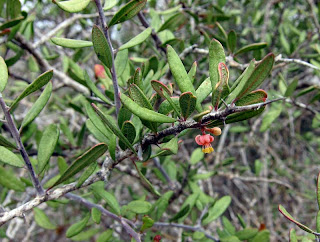Rock Corral Canyon in the Tumacacori Mountains is better known to some as Arizona's Wild Chile Botanical Area, but few have been there. It's reached via a short, but rough dirt road that leads west from the Tumacaori/Carmen Exit #29 on I-19 between Tucson and Nogales. (Click on any photo for a larger image.)
My reason for going in here with Jake Mohlmann and Corey Mitchell earlier this week to was to get to know it for the
Atascosa Highlands Christmas Bird Count. Chris McCreedy had several good birds here, such as Elegant Trogon, Western Flycatcher, Yellow-bellied Sapsucker, Northern Beardless-Tyrannulet, and Hepatic Tanager on this year's CBC. As you can see from the shaded pink area on this map, the upper parts of the canyon are just within the NE part of the CBC circle.
The 2.5-mile entrance road is rough in places, requiring high clearance (and 4wd would be good to have), but it goes through lots of Rufous-winged Sparrow habitat.
The rock corral itself, the Wild Chile Botanical Area (the northernmost natural occurrence of
Capsicum annuum var.
glabriusculum, Cayenne Pepper in Arizona), and the location of the Black-capped Gnatcatchers that Keith Graves found in January 2004 are all actually just outside the circle, but there is plenty of habitat inside the circle. There's a fun NPR Weekend Edition Saturday show with Scott Simon being led by Kevin Dahl too look for chiles. They went up there after a near-record late start to the monsoon (remember the fire in the Santa Ritas in 2005?), and the area was still parched and plant-free. Poor Kevin! You can listen to it
here.
Once inside the CBC area, the canyon is rocky and steep-sided, but with very interesting thorn-scrubby vegetation on the more protected canyon walls.
The very range-limited Goodding's Ash,
Fraxinus gooddingii, occurs here in good numbers. It has small leaves and is evergreen.
Another thorn-scrub-indicating plant is Hopbush,
Dodonaea viscosa, one of few plants found native on every vegetated continent in the world – even on Hawaii. In SE Arizona, wherever Five-striped Sparrows have been found breeding, these two shrubs are common, also occurring with Kidneywood and several other species of shrubs on steep slopes to create a distinctive habitat found nowhere else in this country. One should look for Five-striped Sparrow here after mid-April when they are singing.
The main road going higher into the canyon.
Looking NNE down the canyon. The blue line is my GPS track, showing that we hiked quite a ways up the NW fork side canyon (towards the upper left), but didn't get far up the main draw (towards the lower left).
In some areas, the bottom of the main canyon opens up into mesquite grasslands with scattered oaks, and this is where we relocated the pair of Hepatic Tanagers and the Northern Beardless-Tyrannulet.
The south-facing slopes are more like typical Sonoran desert scrub, and Rock and Canyon Wrens are common here. We also found several Black-chinned Sparrows in this part of the canyon (apparently a recent influx, as they've never been in this area on the CBC).
Another satellite view looking WNW up the middle draw. The CBC area goes all the way up to the watershed divide, and in this shot you can see the green area of the Bear Grass Tank, Murphy Canyon, and Lobo Canyon area and the the turquoise Peck Canyon Complex area.
The middle side canyon to the NW actually has an old mining track one can hike up, in some places very steep and in one stretch annoyingly choked with Catclaw Mimosa,
Mimosa aculeaticarpa.
This side canyon is very well vegetated, and the Evergreen Sumac,
Rhus virens, was full of berries, loved by Hermit Thrushes.
The denser oak woodlands had Bridled Titmouse, Hutton's Vireo, at least two Black-throated Gray Warblers, two Dusky Flycatchers, one Hammond's Flycatcher, and two Red-naped Sapsuckers.
This is near the end of the track.
Looking downcanyon to the SE.
This lush oak grove is at the very head of the canyon, though the intrepid birder could scramble up higher into some steep, oak-lined draws just below the cliffs.
Spiny Hackberry,
Celtis ehrenbergiana, also a good wildlife plant.
Another indicator of good thorn-scrubby vegetation is Kidneywood,
Eysenhardtia orthocarpa.
The upper cliffs had a nook with a roosting Great Horned Owl, and later we saw a Peregrine Falcon flying and calling.
One of the exciting finds was this evergreen vine in the pea family. It was growing up this rather large Texas Mulberry,
Morus micryphylla, right at the end of the track, in a very protected spot. The tree is leafless, and all the leaves belong to the vine.
The big attraction were these gorgeous seeds hanging on to the opened and twisted seed pods. Thanks to my friend Greg Corman and his contacts, I was able to give it a name – Rosary Snoutvine,
Rhynchosia precatoria. And it turns out this is the only place it is know in the entire U.S., first collected in 1977. Check out the specimen maps at the
SEINet Collections website. (Note that their coordinates are a bit off, but the locality description is the same.)
Here's one last satellite view looking down towards the SSW. Chris had found an Elegant Trogon in the side canyon in the lower right, and we hiked up here as well.
The habitat is much more open, so I suspect that the trogon wintering here (one of
eight on the Atascosa Highlands CBC!) roves about the entire canyon complex.
It was surprising to see water still in some of the tinajas.
It's still winter, but in these cold-drained canyons, and especially on warmer sunnier days, there are insects to be found. We saw at least five species of butterflies, and I'm still trying to ID this spur-throated grasshopper. [Update: Thanks to Bob Behrstock for the ID as Gray Bird Grasshopper,
Schistocerca nitens.]



































































